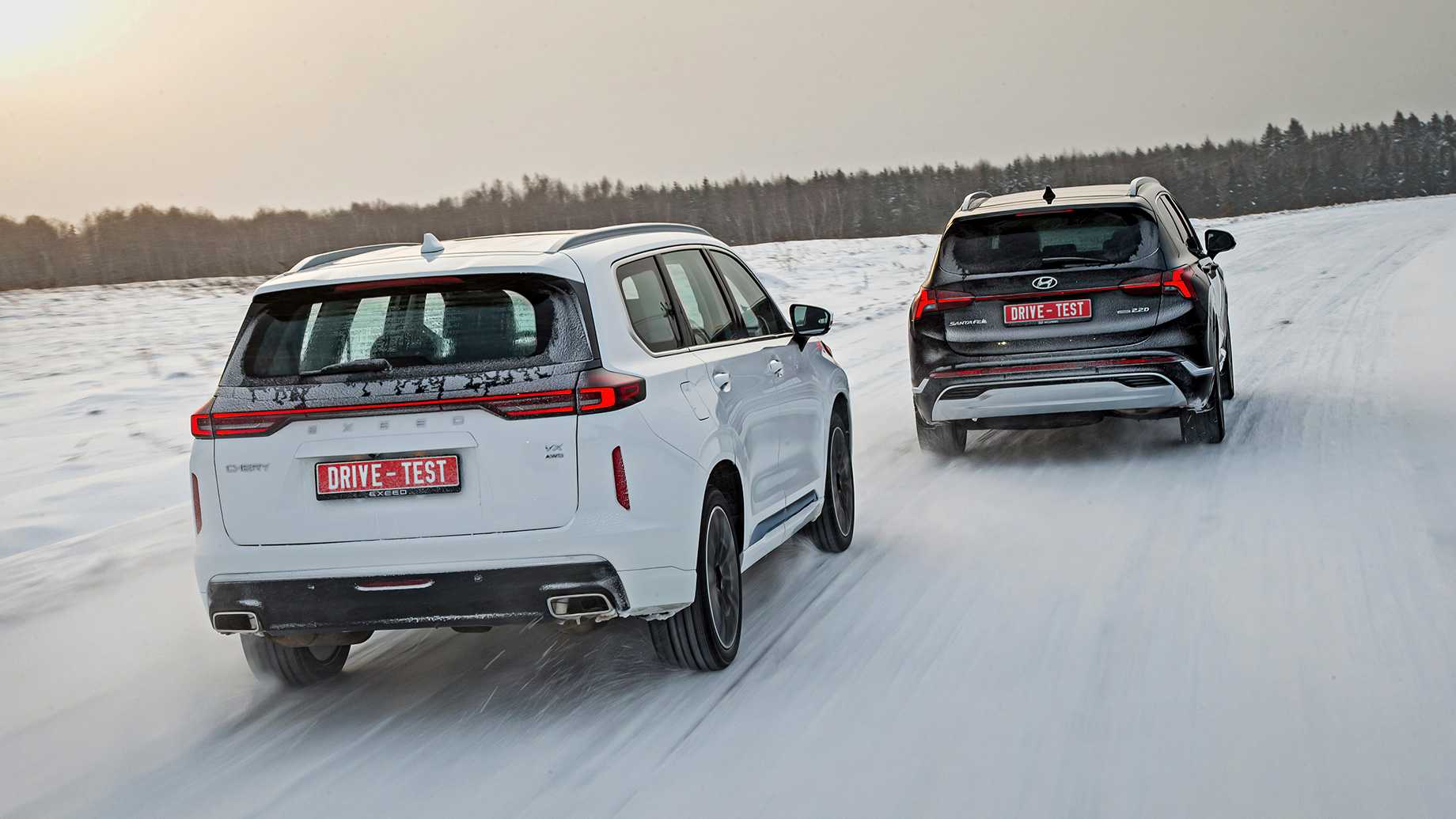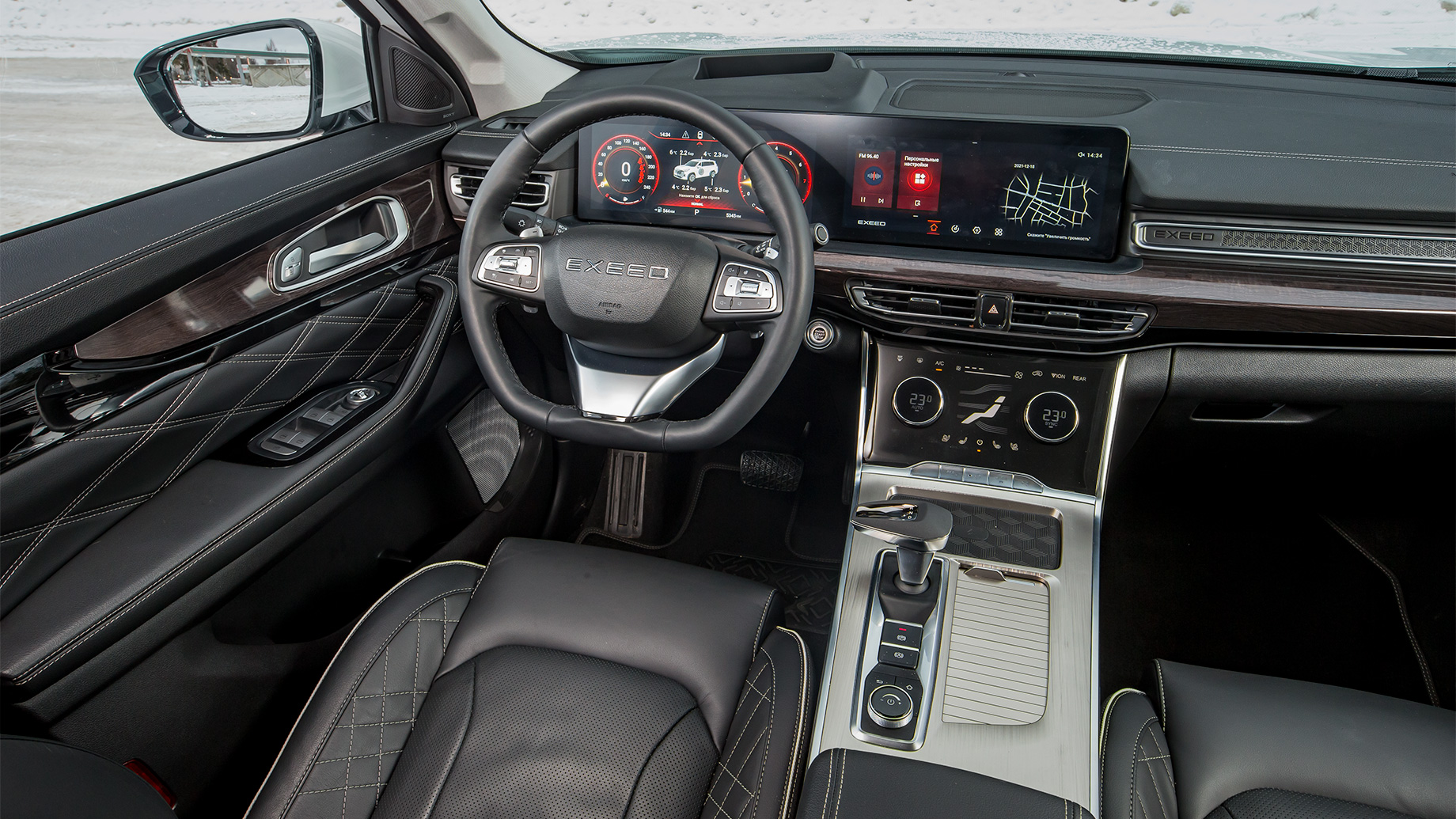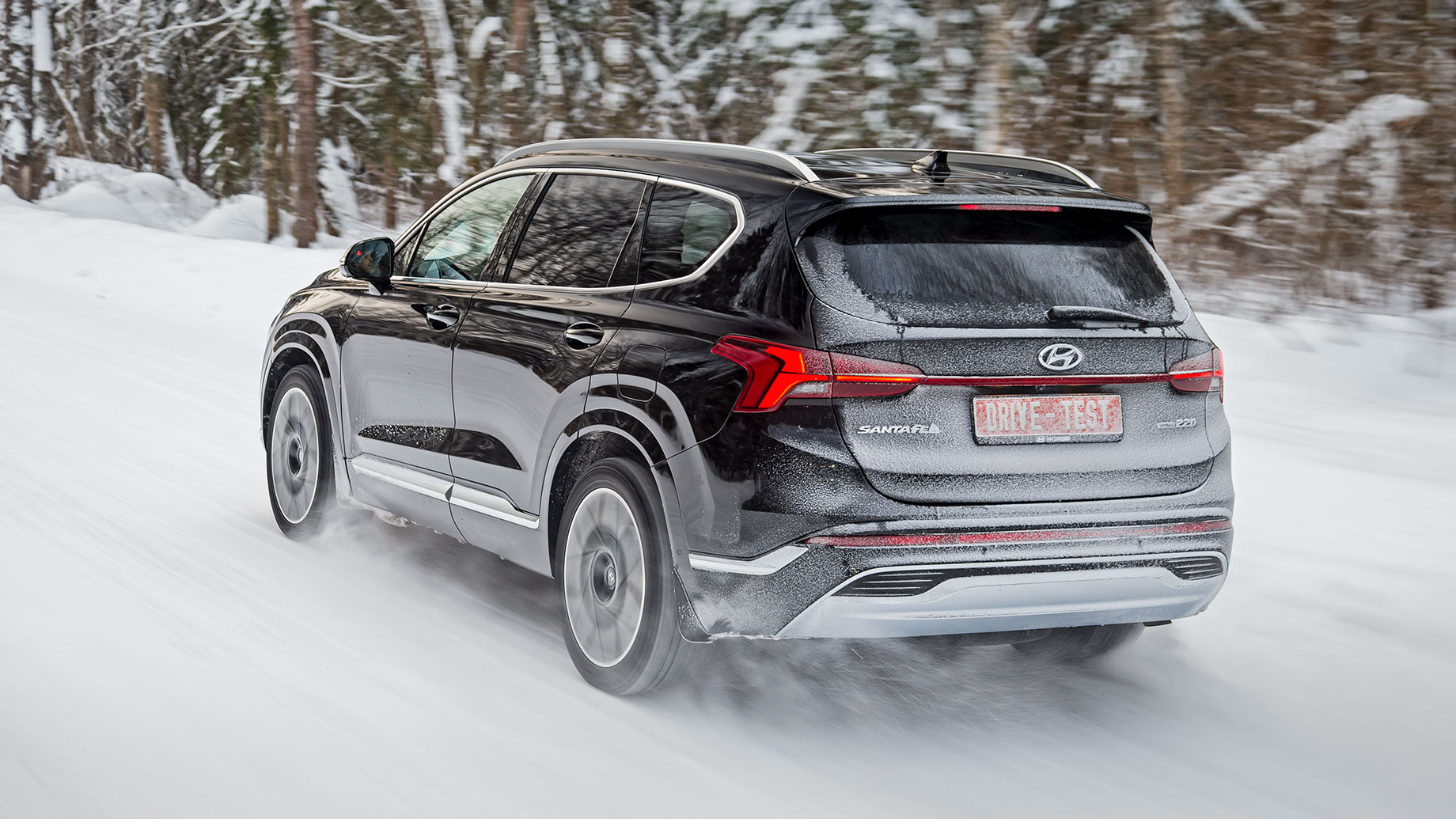If you’re going to buy a non-premium mid-size crossover, the Hyundai Santa Fe or the Kia Sorento mustn’t be overlooked. The recommended price of $39,000-45,500, moderate in these times, promises powerful and generous all-wheel-drive options even with the third seat row. However, dealers sell cars from a warehouse only with a margin that often exceeds $13,000. And when requesting such cars, you aren’t given any specific delivery dates or prices. What if you choose a larger crossover of a lesser-known brand and even save money? The Exeed VX is a great alternative.
At the price of a mid-size SUV, the Chinese offer a five-meter seven-seat car. The Exeed participating in our test drive has a 249 hp 2.0 supercharged gasoline engine. The Santa Fe portfolio includes 2.5 and 3.5 atmospheric engines, as well as a 2.2 turbodiesel. We chose the last option. Its power is less by 50 hp, but it surpasses the competitor’s 4.0 with a torque of 440 N m vs 385. There is parity in other parameters: both crossovers are equipped with direct-shift gearboxes and a multi-disc clutch in the rear axle drive.

Exeed raised the bumpers and sills high, which is useful. With its considerable dimensions, it almost reached the Hyundai Palisade, but it still doesn’t look like a crossover. It is rather a raised minivan because of the flat side plates and the sheer trunk door. It is also not very well assembled: the gaps between the body panels are uneven. The Santa Fe has no problems with that, and its design seems more interesting, thanks to the double-deck optics. Body-colored bumpers and relief arch protectors add some flair. This is a feature of the most expensive Santa Fe Calligraphy model, as well as 20-inch alloy “throwing stars”.
The interior of the Exeed is like an exhibition stand of other companies’ achievements. On top of the pliable front panel, a pair of 12.3 inch displays is installed under one glass, as in Mercedes. Below is a Land Rоver-like sensing climate control unit. At least the Chery concern has a joint venture with the British…
The ergonomics is lame. The central touchscreen is far from the driver, and there is no full-fledged duplicate control on the central tunnel — only a couple of hot keys that send you to the previous or main menu. In addition, the response of all touch surfaces is inhibited, and the buttons on the spokes of the steering wheel are so close to the rim that you accidentally press them every now and then.

It is more comfortable to sit in the driver’s seat -— the front pillars are less tilted, the door openings are wider and higher. The low-mounted seat is nice: solidly made, with unobtrusive side support and a pleasant profile. Modest steering wheel adjustment ranges don’t prevent you from sitting comfortably for your hands without bending your legs too much.
The Santa Fe steering wheel, installed less gently, moves in large ranges, and you can find a comfortable position faster. The geometry of the seating turns out to be more crossover. A seat with a pliable filler, a more advanced lumbar support and a pillow extension is more comfortable. In general, the Hyundai is ergonomically adjusted, although the door pockets are too narrow.
These recesses made of sonorous plastic don’t let you forget that Hyundai is a mass brand. Although the Calligraphy version tries its best to distance itself from such an image. The seats here are trimmed with two-tone Nappa leather, the center console is decorated with real aluminum, and the headlining is covered with alcantara. Two high-resolution displays with a high-quality picture also correspond to the level. The Santa Fe supports Apple CarPlay and Android Auto protocols, while the Exeed perceives only Apple gadgets.
It is easier to get into the second seat row of the Chinese car. There is noticeably more space under legs and above a head, the seat’s range of lengthways adjustment is wider. There is enough width for three passengers, and the passenger in the middle can put his feet on a wide and low tunnel. It’s a pity that a comfortable seat cushion is coupled with an excessively convex back. But the third row is friendly even to adults over 180 cm tall. It’s easy to get there, you sit comfortably without contact with the seats in front or the ceiling.
In the “calligraphic” Santa Fe version, the third seat row is not provided, but it is available in expensive Prestige and High-tech configurations, in a Smart Sense safety kit package. After finding the seven-seater car at the dealership and sitting in it, we quickly retreated. The back row not only frustrates with tightness in all directions, but also forces you to sit in an uncomfortable position with your knees up. An optional separate air conditioner is a small consolation.

On the contrary, the second row is quite competitive. The width of the Santa Fe cabin even surpasses the “Chinese”. The “hump” on the floor is lower. There are curtains on the windows. And most importantly – the seat is much more comfortable. It doesn’t push you out, but gently hugs due to the soft filling. We wanted to fall asleep right on the seat, especially since the angle of the backrest is not worse than one in the Exeed.
The Exeed is convincing as a house, but not as a mobile home. Dynamics are good only on paper. When starting away from rest, the electronics protect the clutches of the robotised gearbox so hard that the VX is still standing when the Santa Fe is already picking-up speed. And then the distance between them only increases. But the Exeed’s motor book data promise an acceleration to 100 km/h in 8.5 seconds against 9.2 seconds declared for the Santa. If there is an uneven coating under the wheels, the VX is even further behind. The sluggishness of the gearbox is added to the slowness of the clutch, which comes into play only after a long slipping of the front wheels.
It’s easier for the Chinese four-wheel-drive car to accelerate while moving, but the high-torque Hyundai is also brisker here. If you turn on the kickdown mode at 60 km/h on the cars at the same time, the VX is inferior from the very first meters. And if you pick up speed from 80 km/h, the Exeed begins to catch up only after 120 km/h. But at a higher speed, the gasoline Exeed is unconditionally in the lead – by 130 km/h, the Santa Fe loses a lot.
The convenience of the VX’s traction control is mediocre. There is no optimal power unit driving mode among the three available. Economical and normal ones stretch reactions to the gas pedal indefinitely, while sport one, on the contrary, aggravates too much. Therefore, the first two are suitable only for congestion, and Sport — for all other cases. And even in Sport mode, the support for the seven-speed robotised box is minimal – the shifts are slow, although smooth.
The Hyundai is not only faster at legal speeds, but also manages its capabilities better. The gas pedal is more responsive in any of the four proposed driving modes. Moreover, Comfort, Sport, and Smart can be used always and everywhere. The eight-speed robotised box works precisely as a direct-shift one, instantly clicking the gears prepared in advance, quickly lowering them. Although it tends towards higher ranges at low speeds. This is treated by Sport mode that removes the seventh and eighth gears from the engine’s rotation.

We haven’t identified a clear leader while assessing ride comfort. Both crossovers are rather uncomfortable. The Exeed is a little more rigid on all the bumps, but this difference is not essential. Both cope well with road’s microprofile and “gentle waves”. But on cracks, joints and larger potholes, sharp vertical accelerations appear, shocks shaking the car’s body are not uncommon.
The Santa Fe’s buyer can at least choose smaller wheels: there are even 17-inch ones among the factory options. While the Exeed is supplied in two trim levels — either with 19-inch base wheels, or ones that are an inch larger than a diameter. In any case, the fundamental problems of the chassis won’t be solved by tire changing.
It’s better not to drive faster than 30 km/h on a bumpy graded road – both cars seriously shake to the accompaniment created by the backlashing interior trim. But even here breakdowns occur more often in the “Chinese”. It suffers more from longitudinal and lateral swaying. Yes, the gearbox and clutch can easily withstand prolonged slippage. But on loose snow, the front axle buries itself faster than the rear one connects, and cross-axling becomes an insurmountable obstacle.
The Santa Fe has better geometric passing ability and smoother bottom side. Imitation of inter-wheel locks works better. But even with the support of off-road modes, the traction control takes a long time to get the car out of the trap. But it’s necessary to do that before the clutch overheats, which happens quite quickly. We couldn’t even drive diagonally onto the planned slope — the rear gear unit stopped showing vital signs after two attempts.

The Santa Fe feels better on a hard surface — it easily changes a movement vector, rolls moderately, slows down effectively. However, there is a hodgepodge on the steering wheel, which is typical for most Korean cars. Bad dynamic ductility, inadequate tractive effort — you drive as if blindfolded. All this, as well as uncontested drifting outside the grip of tires, discourages you from going the pace in corners. The non-switchable stability system is configured without the desire to give an owner the pleasure of snow driving.
We liked the Exeed on a slippery surface more, thanks to the unpretentious and predictable operation of the transmission and the safety electronics that can be disconnected. The brakes work pretty well, although the pedal stroke could be reduced. On asphalt, the VX gives the impression of a raw product, even against the background of the unremarkable Santa. Flabby, unsteady. And there is something strange on the steering wheel in general. From time to time, torque-steers appear, as if a not-quite-sober partner is simultaneously driving the car, giving hints at random.
In short, the Exeed is not very good at driving characteristics. The power unit, steering and suspension ask for reconfiguration. In the absence of high-quality traction control, all-wheel drive is powerless even on light off-road. Ergonomics is also not perfect. At the same time, the engine is enough for life, the acoustic comfort is higher than that of the rival. If you don’t chase the top version, the ride comfort will catch up slightly. For $45,500, you get not only a decent interior, seven full-sized seats and a large trunk, but also a seven-year warranty with a limit of 200,000 km. Of course, there are a lot of reservations in it, as in the three-year Korean one. But given the market situation, the VX is not hopeless.
The Santa Fe is generally nicer. But for the same money, you can count either on a combination of a weak-powered 2.5 engine with rich equipment, or on a high-torque diesel engine in relation to the ascetic Lifestyle configuration. The prices for the Calligraphy version reach $65,700. At the same time, all modifications, regardless of the price, are plagued by poor smoothness, the weakness of all-wheel drive and poorly adjusted steering.
This is a translation. You can read the original here: https://www.drive.ru/test-drive/exeed/hyundai/61cc2ead6966c12d74e0e20a.html

Published February 17, 2022 • 9m to read






